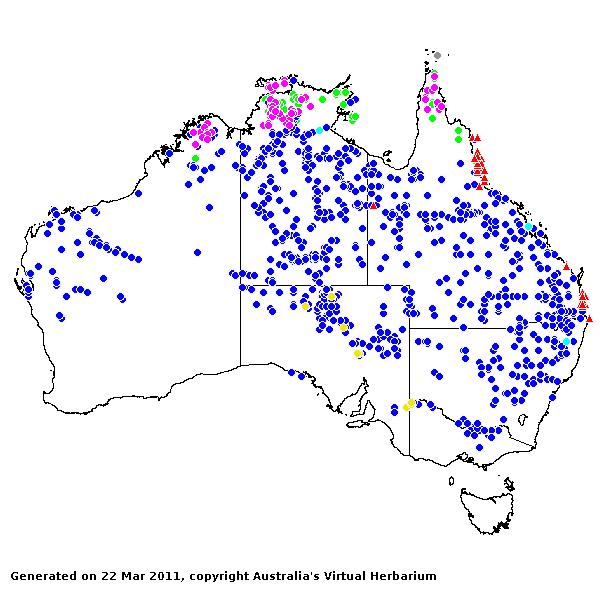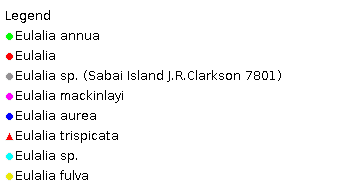Eulalia Rev. Gram.1: 160 (1829).
Derivation:. Named in honour of Eulalie Delile who illustrated Revision des Graminees (1829–1834) by J.S.Kunth.
Taxonomic revisions, nomenclatural references:. B.K Simon, Austrobaileya 3: 84–86 (1989).
Key references (keys and floras):. G.Bentham, Flora Australiensis 7: 459–462 (1878) as Pollinia in part; C.A.Gardner, Flora of Western Australia 1 Gramineae 314 (1952); J.W.Vickery, Flora of New South Wales, Gramineae 19: 27–28 (1961); E.E.Henty, Manual Grasses New Guinea 101 (1969); M.Lazarides, Tropical Grasses S.E. Asia 38–40 (1980); M.Lazarides, Flora of Central Australia 491 (1981); J.C.Tothill and J.B.Hacker, Grasses of Southern Queensland 244–245 (1983); J.P.Jessop, Flora of South Australia 4: 1988–1989 (1986); B.K.Simon, Flora of the Kimberley Region 1174, 1176 (1992); B.K.Simon, Key to Australian Grasses 121 (1993); S.W.L.Jacobs and S.M.Hastings, Flora of New South Wales 4: 434 (1993); N.G.Walsh, Flora of Victoria 2: 618–619 (1994); D.Sharp and B.K.Simon, AusGrass (2002); J.P.Jessop, Grasses of South Australia 518–520 (2006); S.W.L.Jacobs, R.D.B.Whalley & D.J.B.Wheeler, Grasses of New South Wales, 4th ed, 265 (2008).
W.D.Clayton & S.A.Renvoize, Genera Graminum (1986), genus (572).
Native. 30 species, from tropical and subtropical Africa, Asia, Australia. 5 species in Australia, WA, NT, SA, Qld, NSW, and Vic. Also New Guinea and Malesia.
Habit. Perennial (usually) or annual, tufted or decumbent. Leaf blades narrow. Ligule an unfringed membrane or a fringed membrane.
Inflorescence. Inflorescence of spicate main branches (very hairy or silky, often brown or purple), of digitate or subdigitate racemes or spikes, digitate or subdigitate (usually, with a short axis). Spikelet-bearing axes racemes (spiciform), with homomorphic spikelets, disarticulating at joints. Internodes disarticulating obliquely, densely long-hairy.
Spikelets. Spikelets dorsally compressed, 2 flowered, with 1 fertile floret, paired, sessile and pedicelled, in pedicelled/sessile combinations. Fertile spikelets with lower incomplete floret(s), falling with glumes (the pedicelled falling from the pedicel, the sessile falling with the joint and pedicel).
Glumes. Glumes more or less equal, long relative to adjacent lemmas, hairy, awned (the lower glume being rarely bilobed or 2-awned) or awnless, dissimilar (both villous and rigid to leathery, the lower flattened to depressed on the back and more or less bicarinate). Lower glume two-keeled (the keels not winged), flattened on back to concave on back, relatively smooth, 1–9 nerved. Upper glume 1–5 nerved.
Florets. Lower incomplete floret(s) when present, sterile. Lemmas awnless, exceeded by fertile lemmas, similar in texture to fertile lemmas (hyaline), not becoming indurated. Fertile florets 1. Lemmas concurrent with the awn, or bilobed, less firm than glumes (hyaline), not becoming indurated, entire at apex or incised, when incised, deeply cleft or not deeply cleft, awned (nearly always) or muticous, without a germination flap, 1–3 nerved, glabrous. Awns 1, usually from a sinus, geniculate, usually hairless, much longer than body of lemma. Palea present or absent, when present, very reduced, entire, nerveless. Callus short, blunt. Lodicules 2. Stamens (2–)3. Grain small, compressed dorsiventrally or terete. Hilum short. Embryo large. Pedicels free of rachis. Pedicelled spikelets present, similar in shape to sessile spikelet, bisexual.
Kranz Anatomy. C4.
2n = 20 and 40.
Habitat. Helophytic to mesophytic. Grassland, sometimes in moist places. Species of open habitats.
Classification. Panicoideae; Andropogoneae.
Notes. It is related to Saccharum, differing mainly in the digitate racemes and tendancy for the wind-dispersed spikelets to rely upon hairs from the glumes and internode rather than from the callus (Clayton and Renvoize, 1986).
Types Species. E. aurea (Bory) Kunth.
Biogeographic Element. Clifford & Simon 1981, Simon & Jacobs 1990: Old World Tropics.


